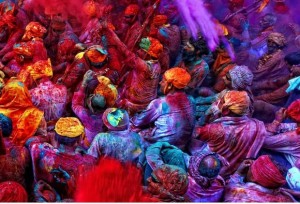
Holi: festival of colours

Holi, Indian spring festival, celebrated at the vernal equinox full moon, also known as the festival of colours, which signifies victory of good over evil,
an ancient Hindu religious festival which has become popular with non-Hindus in many parts of India and Nepal, as well as people of other communities outside Asia.
Holika burned, Prahlada survived. Vishnu appeared and killed Hiranyakashipu. The bonfire is a reminder of the symbolic victory of good over evil, of Prahlada over Hiranyakashipu, of fire that burned Holika. The day after Holika bonfire, where people gather sing and dance in the streets, parks and outside temples, Holi is celebrated. The next morning is a free-for-all carnival of colours, where they chase and colour each other with dry powder and coloured water, with some carrying water guns and coloured water-filled balloons for their water fight. Anyone and everyone is fair game, friend or stranger, rich or poor, man or woman, children and elders.
An exuberant riot of colour takes place in streets, parks, outside temples and buildings with groups carrying drums and musical instruments. The festival is about people meeting to play and laugh, forget and forgive and repair relationships.
Recently, Holi has become a popular festival in Europe as a form of music festival.
